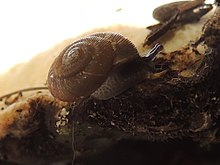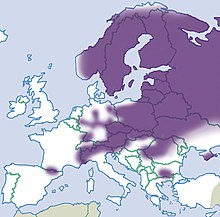Brown bowl snail
| Brown bowl snail | ||||||||||||
|---|---|---|---|---|---|---|---|---|---|---|---|---|

Brown bowl snail ( Discus ruderatus ) |
||||||||||||
| Systematics | ||||||||||||
|
||||||||||||
| Scientific name | ||||||||||||
| Discus ruderatus | ||||||||||||
| ( Hartmann , 1821) |
The brown bowl snail ( Discus ruderatus ), also called brown key snail or brown discus snail, is a species of snail in the family of bowl snails (Patulidae) from the suborder of land snails (Stylommatophora).
features
The housing is very flat, conical or almost disc-shaped and measures 5.5 to 7 mm in diameter and 2 to 3.5 mm in height in the adult stage. The 4 to 4½ whorls increase rapidly and are rounded on the outer edge to very weak shoulders. The seam is flat. The mouth is rounded and is at an angle to the axis of the coil. The edge of the mouth is not thickened, very fragile and not bent over. The navel is wide and deep; it takes up about 1/3 of the maximum case width.
The housing is uniformly yellowish, yellowish brown, greenish brown to reddish brown in color. The non-glossy surface has numerous, regularly arranged strong ribs.
The genital apparatus is structured comparatively simply. The spermatic duct opens laterally directly into the long penis. The penile retractor muscle attaches to the apex of the penis. The vagina and free fallopian tubes are comparatively short. The spermathec is elongated-egg-shaped with a long stem. The protein gland (albumin gland) is finger-shaped and quite large. The soft body of the animal is gray, dark gray to blackish.
Similar Art
The brown bowl snail differs from the spotted bowl snail ( Discus rotundatus ) by the lack of the white spots typical of this species. The case is also a little less flat or slightly higher. The keeled bowl snail ( Discus perspctivus ) is sharply keeled on the periphery.
Geographical distribution and habitat
The species has a huge range that extends from Central Europe to East Asia (palaearctic). In Europe, the distribution is boreo-alpine. The distribution area extends in the north to Scandinavia and Finland . In the south, the Alps and Carpathians are the southern border. There are isolated occurrences south of it in the Pyrenees and in the Rhodope Mountains in the Bulgarian-Greek border area. In Eastern Europe, the species is also found in the lowlands. An isolated occurrence is known from the higher elevations of the Crimea . In Germany it comes in the low mountain ranges ( Harz , Rhön , Vogelsberg , Black Forest and Bavarian Forest ).
In the British Isles , the species still occurred in the post-glacial period, but died out there 8,000 years ago.
The animals live under the bark of rotting wood or under stones in the leaf litter , often also in coniferous forests, in the mountains mostly over 800 m above sea level. At higher altitudes they also occur in open habitats (open meadows, swampy areas), even above the tree line. But there they need stones to hide. In Switzerland and Romania they rise to 2,800 m above sea level. The species is rock indifferent.
Way of life
The animals are hermaphrodites , which usually fertilize each other. Self-fertilization is very rare. According to observations on specimens in Poland, comparatively very few (6 to 15), but very large eggs (diameter: 1.2 × 1.3 mm) are laid in small clutches of 2 to four eggs between April and October. The animals hatch almost synchronously after 17 to 34 days with 1.5 to 2.5 coils. The hatching rate is 50%. Then about half a turn is formed per month. After four months, four turns are usually developed. After that, growth slows down significantly. Sexual maturity is reached in the following year with at least four developed coils. The animals live to be two to three years old.
Taxonomy
The taxon was set up in 1821 by Johann Daniel Wilhelm Hartmann as Helix ruderata . In the literature, the taxon can often be found with Férussac or in older literature with Studer as the author. However, both authors gave no description or indication and the name is a noun nudum in both cases. The taxon is the type species of the genus Discus Fitzinger, 1833.
Danger
In Germany the species is considered endangered.
literature
- Michael P. Kerney, RAD Cameron & Jürgen H. Jungbluth: The land snails of Northern and Central Europe. 384 pp., Paul Parey, Hamburg & Berlin 1983, ISBN 3-490-17918-8 , p. 137.
Individual evidence
- ↑ Jürgen H. Jungbluth and Dietrich von Knorre: Trivial names of land and freshwater mollusks in Germany (Gastropoda et Bivalvia). Mollusca, 26 (1): 105-156, Dresden 2008 ISSN 1864-5127 , p. 121.
- ↑ Klaus Bogon: Landschnecken biology, ecology, biotope protection. 404 p., Natur Verlag, Augsburg 1990 ISBN 3-89440-002-1 , p. 156/57.
- ^ Václav Pfleger: Mollusks. 192 pp., Artia-Verlag, Prague, 1984, p. 76.
- ↑ a b Alexandru V. Grossu: Gastropoda Romaniae 4 Ordo Stylommatophora Suprafam: Arionacea, Zonitacea, Ariophantacea şi Helicacea. 564 pp., Bucharest 1983, pp. 36/37.
- ↑ AnimalBase: Discus ruderatus (Hartmann, 1821)
- ↑ Elżbieta Kuźnik-Kowalska: Life cycle and population dynamics of Discus ruderatus (Férussac, 1821) (Gastropoda: Pulmonata: Endodontidae). Folia Malacologica 14 (1): 35-46. 2006 PDF
- ^ Johann Daniel Wilhelm Hartmann: System of terrestrial and river snails in Switzerland. With a comparative listing of all species found in neighboring countries, Germany, France and Italy. Neue Alpina, 1: 194-268, plates I-II (= 1-2). Winterthur, 1821. Online at Google Books , p. 231.
- ↑ Francisco W. Welter-Schultes: European non-marine molluscs, a guide for species identification = identification book for European land and freshwater mollusks. A1-A3 S., 679 S., Q1-Q78 S., Göttingen, Planet Poster Ed., 2012 ISBN 3-933922-75-5 , ISBN 978-3-933922-75-5 (S. 215)
- ^ Vollrath Wiese: The land snails of Germany. 352 pp., Quelle & Meyer, Wiebelsheim 2014 ISBN 978-3-494-01551-4 (p. 161)

